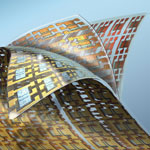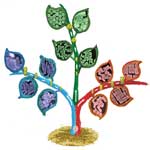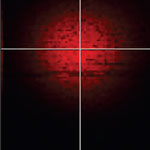Showing Spotlights 169 - 176 of 207 in category All (newest first):
 Eric Drexler replies to yesterday's Spotlight on Feynman and nanotechnology. 'Neither Feynman nor the vision of molecular manufacturing created the fields that have joined to become 'nanotechnology', nor did they provide the concrete scientific opportunities and technological applications that drive it forward. However, what set nanotechnology on its path to prominence was not a sudden realization by the public and politicians that new molecules and nanostructures have a host of applications in materials, sensors, and so on. It was, and is, the promise of revolutionary advances in atomically precise manufacturing, advances that will build on the technology platform now emerging from nanotechnology research.'
Eric Drexler replies to yesterday's Spotlight on Feynman and nanotechnology. 'Neither Feynman nor the vision of molecular manufacturing created the fields that have joined to become 'nanotechnology', nor did they provide the concrete scientific opportunities and technological applications that drive it forward. However, what set nanotechnology on its path to prominence was not a sudden realization by the public and politicians that new molecules and nanostructures have a host of applications in materials, sensors, and so on. It was, and is, the promise of revolutionary advances in atomically precise manufacturing, advances that will build on the technology platform now emerging from nanotechnology research.'
Oct 23rd, 2009
 In December 2009 we will receive a series of reminders of the fiftieth anniversary of Richard Feynman's noted talk, 'There's Plenty of Room at the Bottom'. As commentaries appear in scientific journals, the nanotechnology community will have multiple opportunities to think about the role of Feynman's talk in the history of nanotechnology. Feynman's 1959 talk has been widely hailed as the origin of nanotechnology. It is a comprehensive vision of controlling matter at the nanoscale, including controlling individual atoms. However, at this point, there are two very different views of the role of Feynman's talk in the history of nanotechnology: 1. Everybody knows that Feynman's 'Plenty of Room' is the origin of nanotech. 2. The emergence of nanotech had little to do with Feynman's talk.
In December 2009 we will receive a series of reminders of the fiftieth anniversary of Richard Feynman's noted talk, 'There's Plenty of Room at the Bottom'. As commentaries appear in scientific journals, the nanotechnology community will have multiple opportunities to think about the role of Feynman's talk in the history of nanotechnology. Feynman's 1959 talk has been widely hailed as the origin of nanotechnology. It is a comprehensive vision of controlling matter at the nanoscale, including controlling individual atoms. However, at this point, there are two very different views of the role of Feynman's talk in the history of nanotechnology: 1. Everybody knows that Feynman's 'Plenty of Room' is the origin of nanotech. 2. The emergence of nanotech had little to do with Feynman's talk.
Oct 22nd, 2009
 Nanotechnologies are opening vast new opportunities for scientists, engineers and entrepreneurs to participate in solving some of the major problems facing mankind today. But the road from idea to commercially viable product or process is long. Especially when it comes to nanotech innovations, the research and development phase tends to be relatively lengthy. To help potential nanotechnology start-up founders with shaping their plans, Nanowerk, the leading nanotechnology information service, and Nanostart, the world's leading nanotechnology venture capital company, have teamed up to provide this useful guide which particularly addresses the funding aspects of nanotechnology start-ups, along with answers to some of the most commonly asked questions.
Nanotechnologies are opening vast new opportunities for scientists, engineers and entrepreneurs to participate in solving some of the major problems facing mankind today. But the road from idea to commercially viable product or process is long. Especially when it comes to nanotech innovations, the research and development phase tends to be relatively lengthy. To help potential nanotechnology start-up founders with shaping their plans, Nanowerk, the leading nanotechnology information service, and Nanostart, the world's leading nanotechnology venture capital company, have teamed up to provide this useful guide which particularly addresses the funding aspects of nanotechnology start-ups, along with answers to some of the most commonly asked questions.
Oct 21st, 2009
 Here is the book you all have been waiting for: Nano-Society - Pushing the boundaries of technology. Written by Nanowerk's Michael Berger, this book puts a spotlight on some of the scientists who are pushing the boundaries of technology and it gives examples of their work and how they are advancing knowledge one little step at a time. Nano-Society is the latest addition to RSC Publishing's Nanoscience and Nanotechnology series. Edited by Sir Harry Kroto, Paul O'Brien, and Harold Craighead, the series provides a comprehensive source of information on research associated with nanostructured materials and miniaturized lab-on-a-chip technologies. The book covers 122 very specific research projects that are happening in laboratories around the world and provides commentaries from the scientists in their own words.
Here is the book you all have been waiting for: Nano-Society - Pushing the boundaries of technology. Written by Nanowerk's Michael Berger, this book puts a spotlight on some of the scientists who are pushing the boundaries of technology and it gives examples of their work and how they are advancing knowledge one little step at a time. Nano-Society is the latest addition to RSC Publishing's Nanoscience and Nanotechnology series. Edited by Sir Harry Kroto, Paul O'Brien, and Harold Craighead, the series provides a comprehensive source of information on research associated with nanostructured materials and miniaturized lab-on-a-chip technologies. The book covers 122 very specific research projects that are happening in laboratories around the world and provides commentaries from the scientists in their own words.
Sep 28th, 2009
 Sand. Shrubs. Burst tires. More sand. The last thing you would expect as you drive along the Red Sea near Mecca is to encounter an ultramodern science city. Yet there it is. Appearing after an 80 kilometer drive from Jeddah, Saudi Arabia's second-largest city, the 36 square kilometer campus of King Abdullah University for Science and Technology (KAUST) appears like a Fata Morgana out of the desert sand. Yesterday, September 23rd, King Abdullah of Saudi Arabia officially opened the country's most modern and ambitious university near the old fishing village of Thuwal. Nanowerk was invited to attend the spectacular opening ceremony. Much more than a future elite university, the vision behind KAUST is to create the nucleus of a modern society, free from the strict religious dictates of a conservative Islamic culture, and laying the foundation for a science and technology based society of future generations.
Sand. Shrubs. Burst tires. More sand. The last thing you would expect as you drive along the Red Sea near Mecca is to encounter an ultramodern science city. Yet there it is. Appearing after an 80 kilometer drive from Jeddah, Saudi Arabia's second-largest city, the 36 square kilometer campus of King Abdullah University for Science and Technology (KAUST) appears like a Fata Morgana out of the desert sand. Yesterday, September 23rd, King Abdullah of Saudi Arabia officially opened the country's most modern and ambitious university near the old fishing village of Thuwal. Nanowerk was invited to attend the spectacular opening ceremony. Much more than a future elite university, the vision behind KAUST is to create the nucleus of a modern society, free from the strict religious dictates of a conservative Islamic culture, and laying the foundation for a science and technology based society of future generations.
Sep 24th, 2009
 Sometimes we get bombarded with emails from people who are new to the field about certain aspects of nanotechnology - can it cure cancer? Where can I buy nanobots? What is a nanomaterial? Is nanotechnology dangerous? And so forth. You get the idea. The question asked most often is simply this: 'What is nanotechnology?' That's why we have decided to add a new segment to our Nanowerk website that we call 'Ten things you should know about nanotechnology'. What we have been trying to do here is to provide a brief overview of some important aspects and issues and answer some of the basic questions on nanotechnologies. Of course, there is lots of important information that we omitted. But we feel that, if you are new to nanotechnology, this is a good point to start.
Sometimes we get bombarded with emails from people who are new to the field about certain aspects of nanotechnology - can it cure cancer? Where can I buy nanobots? What is a nanomaterial? Is nanotechnology dangerous? And so forth. You get the idea. The question asked most often is simply this: 'What is nanotechnology?' That's why we have decided to add a new segment to our Nanowerk website that we call 'Ten things you should know about nanotechnology'. What we have been trying to do here is to provide a brief overview of some important aspects and issues and answer some of the basic questions on nanotechnologies. Of course, there is lots of important information that we omitted. But we feel that, if you are new to nanotechnology, this is a good point to start.
Aug 20th, 2009
 Many of the properties of a given nanoparticle not only depend on its chemical composition but also on its size and shape, i.e. its morphology. These morphological factors have significant impact on a nanoparticle's optical and catalytic properties. Accordingly, nanoparticle manufacturers have developed numerous 'recipes' for synthesizing particles with desired size and shape. To facilitate systematic investigation on the morphology-property relationship, it would be highly desirable if one reaction system can be engineered to yield as many different shapes as possible with minimal degree of parameter tuning. To that end, researchers proposed a way to systematically engineer the morphologies of nanoparticles by constructing an evolutionary tree, which consists of several pathways, each showing a 'string' of evolving shapes over the courses of a single reaction. The tree not only displays the relationship between different shapes, but also offers designing principles for producing more complex shapes by crossing over different pathways during nanoparticle growth.
Many of the properties of a given nanoparticle not only depend on its chemical composition but also on its size and shape, i.e. its morphology. These morphological factors have significant impact on a nanoparticle's optical and catalytic properties. Accordingly, nanoparticle manufacturers have developed numerous 'recipes' for synthesizing particles with desired size and shape. To facilitate systematic investigation on the morphology-property relationship, it would be highly desirable if one reaction system can be engineered to yield as many different shapes as possible with minimal degree of parameter tuning. To that end, researchers proposed a way to systematically engineer the morphologies of nanoparticles by constructing an evolutionary tree, which consists of several pathways, each showing a 'string' of evolving shapes over the courses of a single reaction. The tree not only displays the relationship between different shapes, but also offers designing principles for producing more complex shapes by crossing over different pathways during nanoparticle growth.
Jul 29th, 2009
 In a recent Nanowerk Spotlight we reported on a single molecule approach to directly visualize and map protein binding sites on DNA using fluorescent quantum dots. One of the challenges the researchers in this work had was to measure distances between probes bound to combed DNA with nanometer resolution. Whereas very short distance (below 10 nm) can be assessed by FRET measurements and distances above the Rayleigh criterion can be measured, say, with a standard microscopy picture and a ruler, distances in between need to be addressed differently. This is were a novel approach by scientists at UCLA fills the gap, and, as they claim, better than other techniques do.
In a recent Nanowerk Spotlight we reported on a single molecule approach to directly visualize and map protein binding sites on DNA using fluorescent quantum dots. One of the challenges the researchers in this work had was to measure distances between probes bound to combed DNA with nanometer resolution. Whereas very short distance (below 10 nm) can be assessed by FRET measurements and distances above the Rayleigh criterion can be measured, say, with a standard microscopy picture and a ruler, distances in between need to be addressed differently. This is were a novel approach by scientists at UCLA fills the gap, and, as they claim, better than other techniques do.
May 27th, 2009
 Eric Drexler replies to yesterday's Spotlight on Feynman and nanotechnology. 'Neither Feynman nor the vision of molecular manufacturing created the fields that have joined to become 'nanotechnology', nor did they provide the concrete scientific opportunities and technological applications that drive it forward. However, what set nanotechnology on its path to prominence was not a sudden realization by the public and politicians that new molecules and nanostructures have a host of applications in materials, sensors, and so on. It was, and is, the promise of revolutionary advances in atomically precise manufacturing, advances that will build on the technology platform now emerging from nanotechnology research.'
Eric Drexler replies to yesterday's Spotlight on Feynman and nanotechnology. 'Neither Feynman nor the vision of molecular manufacturing created the fields that have joined to become 'nanotechnology', nor did they provide the concrete scientific opportunities and technological applications that drive it forward. However, what set nanotechnology on its path to prominence was not a sudden realization by the public and politicians that new molecules and nanostructures have a host of applications in materials, sensors, and so on. It was, and is, the promise of revolutionary advances in atomically precise manufacturing, advances that will build on the technology platform now emerging from nanotechnology research.'
 Subscribe to our Nanotechnology Spotlight feed
Subscribe to our Nanotechnology Spotlight feed





